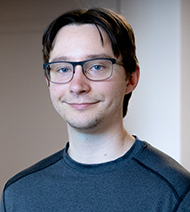Sean Fayfar

ORCID: 0000-0002-3097-0054
Education
Ph.D., Physics, University of Missouri, Columbia, MO 2021
M.S., Physics, University of Missouri, Columbia, MO 2020
B.S., Physics, Illinois State University, Normal, IL 2016
Research Interests
Sean Fayfar is an experimental physicist with a background in computation studying the complex materials proposed for use in advanced nuclear reactors. He is also interested in developing novel neutron scattering and imaging instrumentation at the MIT Reactor.
Materials in nuclear energy
The components within nuclear reactors must withstand extreme conditions that include high temperatures, high radiation dose, and potentially high pressures. Some advanced reactor designs, called Molten Salt Reactors (MSRs), propose to use molten salts as the coolant material as well as the carrier of fissile material. These molten salts benefit from having similar thermal transport properties as water while being able to operate at elevated temperatures while retaining ambient pressures. However, their structure across temperature and composition regimes needs to be better understood to accurately predict their thermal properties. We use neutron and X-ray scattering techniques to investigate their structure in coordination with molecular dynamics simulations.
We are also investigating nuclear graphite and metal hydrides which can be used as reflectors and moderators within reactors. Nuclear graphite is found in most reactor designs due to its strong structural integrity and beneficial neutronic properties. Nuclear graphite has a complex pore structure that changes upon irradiation; we are studying this pore structure to understand how graphite changes during the lifetime of reactors. Metal hydrides are promising new moderator materials. We are evaluating their stability after irradiation using neutron imaging.
Development of novel neutron instrumentation
The MIT Reactor has a number of neutron beam ports utilized for research. We currently operate a neutron imaging/tomography beamline that is also used for developing new instruments. We are building a prototype stress-strain diffractometer that uses a polychromatic beam (all neutron energies) with focusing analyzers and position sensitive detectors. This design aims to improve the efficiency of measurements through multiplexing with a series of analyzer-detector pairs. We are also upgrading our instrument control system to use the open-source Bluesky framework along with EPICS for hardware communication. Our developments of control system software can be found at https://github.com/MIT-NRL
Publications
S. Fayfar et al., Complex Structure of Molten FLiBe (2LiF-BeF2) Examined by Experimental Neutron Scattering, X-Ray Scattering, and Deep-Neural-Network Based Molecular Dynamics, PRX Energy 3, 013001 (2024).
S. Fayfar, G. Zheng, D. Sprouster, M. S. J. Marshall, E. Stavitski, D. Leshchev, and B. Khaykovich, In-Situ Analysis of Corrosion Products in Molten Salt: X-Ray Absorption Reveals Both Ionic and Metallic Species, ACS Omega 8, 24673 (2023).
A. Bretaña, S. Fayfar, and W. Montfrooij, Quantitative Solution to the Kondo Lattice Problem, Phys. Rev. B 108, 045122 (2023).
S. D. Fayfar, Protected Percolation: A New Universality Class Pertaining to Quantum Critical Systems, Thesis, University of Missouri--Columbia, 2021.
S. Fayfar, A. Bretaña, and W. Montfrooij, Protected Percolation: A New Universality Class Pertaining to Heavily-Doped Quantum Critical Systems, Journal of Physics Communications (2021).
S. Fayfar, A. Bretaña, and W. Montfrooij, Effects of Disorder on Harris-Criterion Violating Percolation, Physical Review E 104, 034110 (2021).
A. Bretaña, S. Fayfar, and W. Montfrooij, Evidence for Magnetic Clusters in Stoichiometric Quantum Critical CeRu2Si2 Physical Review B 104, 085135 (2021).
